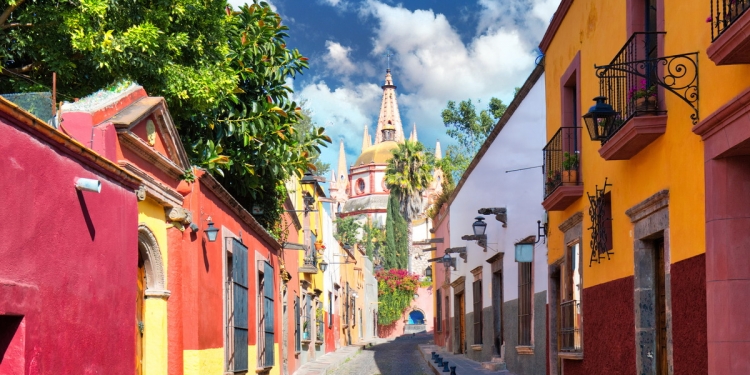Property prices have been rising steadily in Mexico over the last decade—driven by a range of forces including the country’s stable macro-economics, foreign residents moving here and buying property, and the emergence of residential mortgages offered by banks making home ownership a possibility for the growing Mexican middle class.
Realty markets are localized in Mexico
Mexico is a vast country with wide regional variations in lifestyle, topography and climate, infrastructure, transport links, and local amenities. The country’s real estate markets are highly localized, and accurate data in regard to prices and historical trends is not easy find in aggregate as it is in the US, Canada, and Europe.
Property portals give you insights into asking prices and rents
In recent years, a series of Mexican property portals have emerged which aggregate property listings nationally: MetrosCubicos, VivaAnuncios and InMuebles24 are the principal ones you ought to review to gauge current asking prices.
The portals also feature extensive listings for home rentals in towns and cities across Mexico, so if you’re planning to rent a home here, the portals are a good way to assess rental prices and find a home to rent.
These sites are helping to bring additional data together for buyers and sellers, but remember that asking prices and sale prices are rarely the same. Real estate agents tell us that closing prices on property here are typically between 10 and 15 per cent lower than market asking prices, depending on the location, state of the property, as well as individuals’ situations surrounding the transaction.
House price data is not centralized
There is no publicly-accessible ‘official’ central register of house prices in Mexico, and even some of the ‘informal’ registers which exist may peddle doubtful data, as sellers are not always forthcoming about the full details concerning the prices at which properties changed hands.
Official registers do exist —on records at local government and Notary Public offices— but getting access to these data is tricky, and generally has to be undertaken in-person on state-by-state (or even municipality) basis, making it near-impossible for any individual to build a precise picture of what is trending regionally or nationally.
Note also, that transactions of untitled properties sold on agrarian terms won’t appear in any official statistics, and the buyers’ pool in this market is smaller because these properties cannot be financed or used for collateral.
Some private firms and government agencies exist that commission data-gathering exercises and compile reports based on those data. The depth and scope of their data may be limited, but they add perspective and insights for potential buyers.
Other sources of house price data in Mexico
In the absence of a central register of prices showing current trends, potential buyers, and sellers seeking to set a price on their property for sale, can repair to a variety of other data sources for guidance.
Local real estate agents
Locally based and well-established realty agents are among the better people to talk to for an indication of prices in a given market. The good ones will have been operating in the market for some while and will have a balanced perspective about the price levels similar houses in specific local neighborhoods have been listed at and sold for.
The disadvantage of this information source is that agents are inevitably vested in talking-up the price of the product they sell; some agents may represent the buyer and the seller simultaneously (this is not illegal in Mexico as it is in some US states) and so it’s prudent for buyers especially to check other information sources to cross-check price levels. You can learn more about this on our comprehensive guide to working with realty agents in Mexico.
Live locally for a while, and get a feel for the market
An excellent way to gauge local prices is to base yourself locally for a while (see also: renting) in the area where you are interested in investing. There is no substitute for getting to know the locale, talking to the locals, and probing friends and local contacts about recent market activity, scoping-out the different neighborhoods, and in doing so obtaining a first-hand sense of the local market. Doing this can also help you to negotiate a better price.
Foreign buyers might overpay for Mexican property
Some foreign buyers have a tendency to overpay for property in Mexico by assessing ‘value’ to prices in relation to their home-country experiences instead of in relation to local market characteristics and conditions. Prices and value ought to be perceived in relation to local markets, not to one’s experience of buying or renting elsewhere, and especially not compared to property markets abroad.
Consider how sellers in Mexico are valuing their properties
Another way to arm yourself with local knowledge is to consider how existing home owners in Mexico are valuing the properties they want to sell. This article on Mexperience describes typical methods that sellers use to assess residential property values in Mexico, and outlines the key factors that tend to influence sellers’ listing prices.
Reviewing this information can help you to gain additional perspectives as you research prices and consider the value of property for sale in Mexico.
Hire a property assessor
Homeowners in Mexico can hire the services of a property assessor —a valuation agent— who, for a fee of around US$150-$300 will compose a detailed valuation report that will be founded on an array of factors including research of recent sale prices in the area, the desirability of the locality, amenities the property offers, as well as the size and condition of the current land and construction.
Sellers use this report as supporting evidence for their asking price —and some sellers might assert that the valuation is Gospel— but remember that these valuations constitute a professional opinion, not a buyer’s tangible offer.
Offers and direct negotiation are key tools
While various disconnected data sources exist to help sellers and buyers gauge the present market value for real estate, the price of a piece of land or a property in Mexico is most-often determined somewhere between “what the current owner is willing to accept” and “what a buyer is willing to pay.”
Cash buyers have leverage
Most foreigners who have been purchasing real estate in Mexico over the years have purchased using cash, by trading down from —or out of— property markets in their home countries and exchanging these for a home in Mexico, oftentimes as part of a retirement plan.
This form of direct capital investment has provided an additional support mechanism for the residential property market in Mexico, and with buyers not subject to the usual pressures of property repayment schedules and interest charges, the market can remain stable even as prices soften or fall.
Serious interest deserves an offer
The asking price is almost always negotiable, except in very buoyant periods where buyers outstrip sellers. If you are seriously interested in a property you have viewed, then you should make an offer based on your research and intuition.
Experienced local agents tell us that “the most important thing is to make an offer.” Sometimes “low-ball” offers are rejected without further discussion; and sometimes the sellers engage. We’re told that sometimes relatively-high asking price offers are accepted by buyers without negotiation, and conversely some exceptionally low-ball offers are immediately accepted by sellers.
The negotiations tend to pivot between:
- the underlying reasons current owners may have for selling which may never become apparent to the buyer but which influence the negotiations and the price sellers are willing to accept; and
- underlying reasons buyers might have that can include things like an emotional feeling they encounter in relation to a property they have viewed, or a hurried moving schedule.
Some homes are overpriced
Some homes listed for sale are simply overpriced with owners quite unwilling to budge or negotiate on the matter—and they often appear in no hurry to sell.
Some homes stay on the market (or see-saw on and off of it) for many years when current owners hold a firm belief that the value of the property is far higher than buyers are currently willing to pay—thus creating an impasse.
In these situations it’s prudent for potential buyers to consider alternative properties and ‘move on’ from any notions they may have about buying an overpriced property held by an unyielding seller.
Price trends and lifestyle priorities
Buoyancy in Mexico’s property markets ebbs and flows, like anywhere else. Waves of buoyancy tend to be localized, although regardless of location, prices will ultimately be determined by the same factors which often drive price increases —primarily capital flows and demographics— although broader influences can also cause price surges and declines.
Price buoyancy continues in popular places
Popular places like southern Baja California, Puerto Vallarta, and the Riviera Maya have experienced property booms that appear to have no end, fueled by high demand as Americans and Canadians look south for beachfront property of the type that has become unaffordable in the US and Canada to all except the ultra-wealthy.
Foreign buyers are also turning their attention inland, beyond the coasts to highland colonial cities where the year-round climate is temperate and improving transport links and local amenities increase the appeal of these locations. This is driving demand (and raising prices) in lesser-known and under-explored towns and cities which hitherto experienced relatively low house price inflation: among these are Querétaro, Guanajuato, Valle de Bravo, Puebla, Tepoztlán, Pátzcuaro, and Mérida.
Considering your true lifestyle needs
As the capital cost of acquiring property increases, we recommend you consider reading this article about your lifestyle needs as you scout for a place to live and especially when you intend to make a significant property purchase in Mexico. The advice in that article shares some helpful insights about the types of areas which are likely to continue benefiting from investor interest; they are the typically the ones that offer value for money, the strength of the local community, the location’s character and potential, and local amenities which people commonly seek when moving to a new place.
Total cost of property ownership in Mexico
Residential property in Mexico continues to attract buyers from abroad for another reason: the total cost of ownership is lower than it is in the US, Canada, or Europe. Ownership costs are mitigated by lower property taxes (although these have been rising in recent years, albeit from a low base); lower construction costs (but land prices and materials costs have been rising significantly of late); lower ongoing maintenance fees; and a lower cost of living.
Learn more about real estate in Mexico
We publish detailed and continuously updated information about real estate in Mexico that shares valuable local insights and knowledge about property markets for buyers, owners, renters, and sellers.
Resources for Living & Lifestyle in Mexico
Mexperience offers you a comprehensive online resource of information and local knowledge to help you discover Mexico, explore choices, find opportunities and plan a new life in Mexico. Our resources include:
- Insightful articles about living and lifestyle in Mexico
- Complete guides to aspects of living in Mexico
- A regular Mexico Newsletter you can subscribe to for free
The information contained in this article is published in good faith and is not intended to constitute personal, professional, legal, financial or investment advice, nor replace the services of professional advisors.
Mexico in your inbox
Our free newsletter about Mexico brings you a monthly round-up of recently published stories and opportunities, as well as gems from our archives.

















Excellent article.
Recently I sent an email directly to Mexperience thanking
you for all your wonderful tips throughout my Mexico trip
-buying a pre construction condo in El Tigre, NAY to then
purchasing land in LaCruz de Huanacaxtle – 2006
Building on the property in 2014 after establishing permanent
residency.
It truly has been a wonderful Mexperience!
Now my home in BNayar is for sale with Mexhome.com
Please feel free to share this with any colleagues, friends or
people who express and interest in buying this month.
Thanks again,
Sherry
Property 33 Tortugas
Lacruz de Huanacaxtle
NAY
Mexhome.com
Property/30575
*As a senior needing my homeland insurance benefits
again this year unable to live here full time – it is my
hope to find qualified buyers – willing to negotiate $$